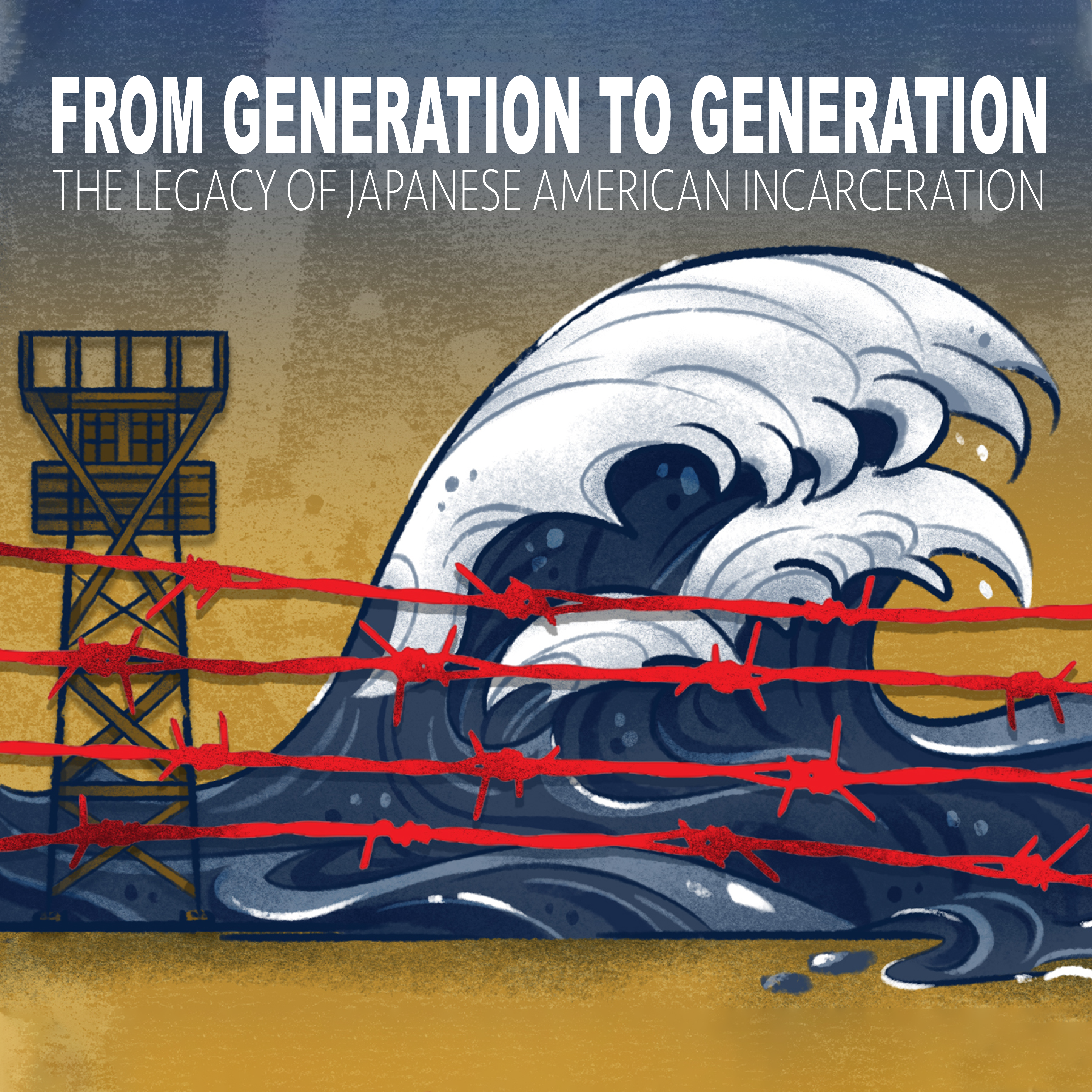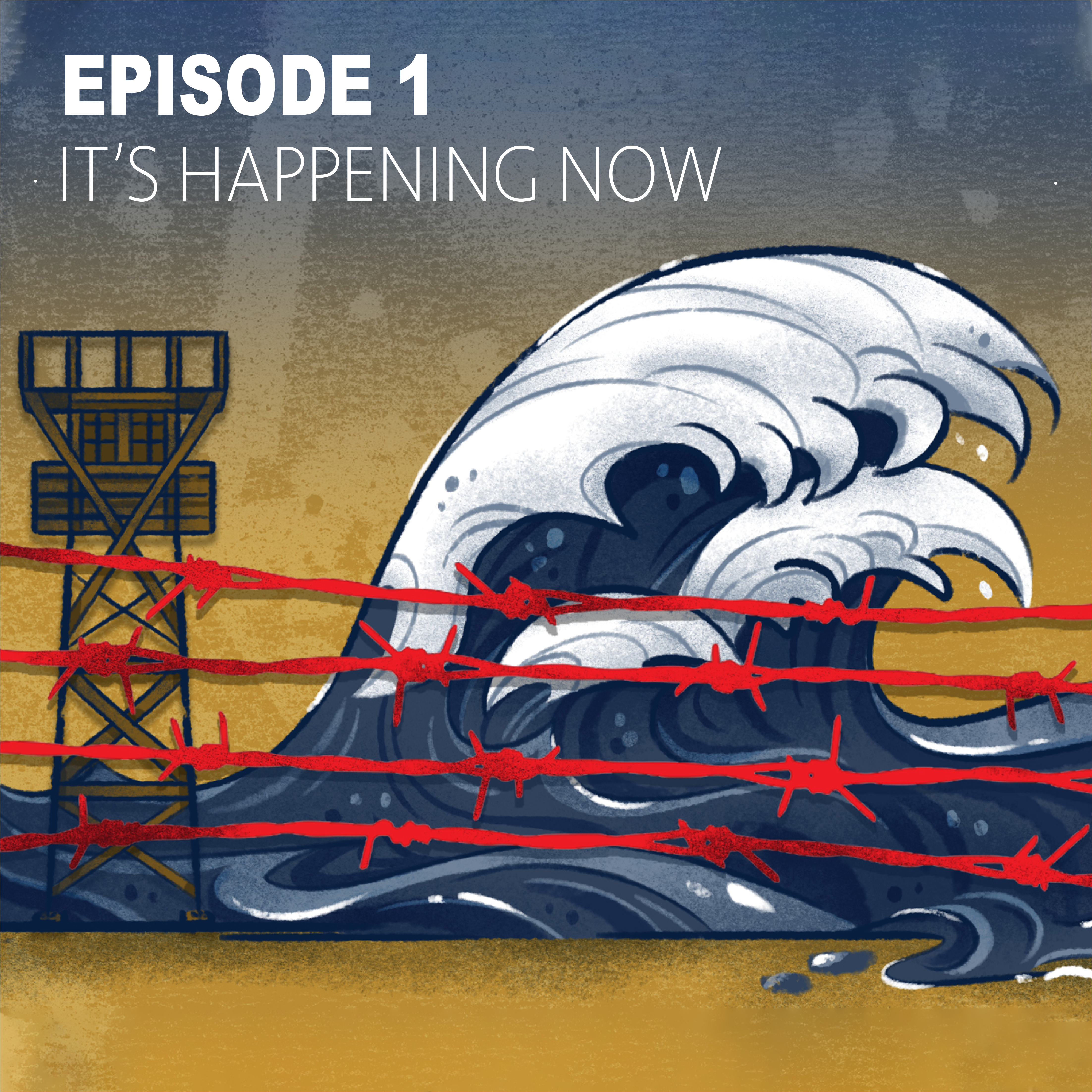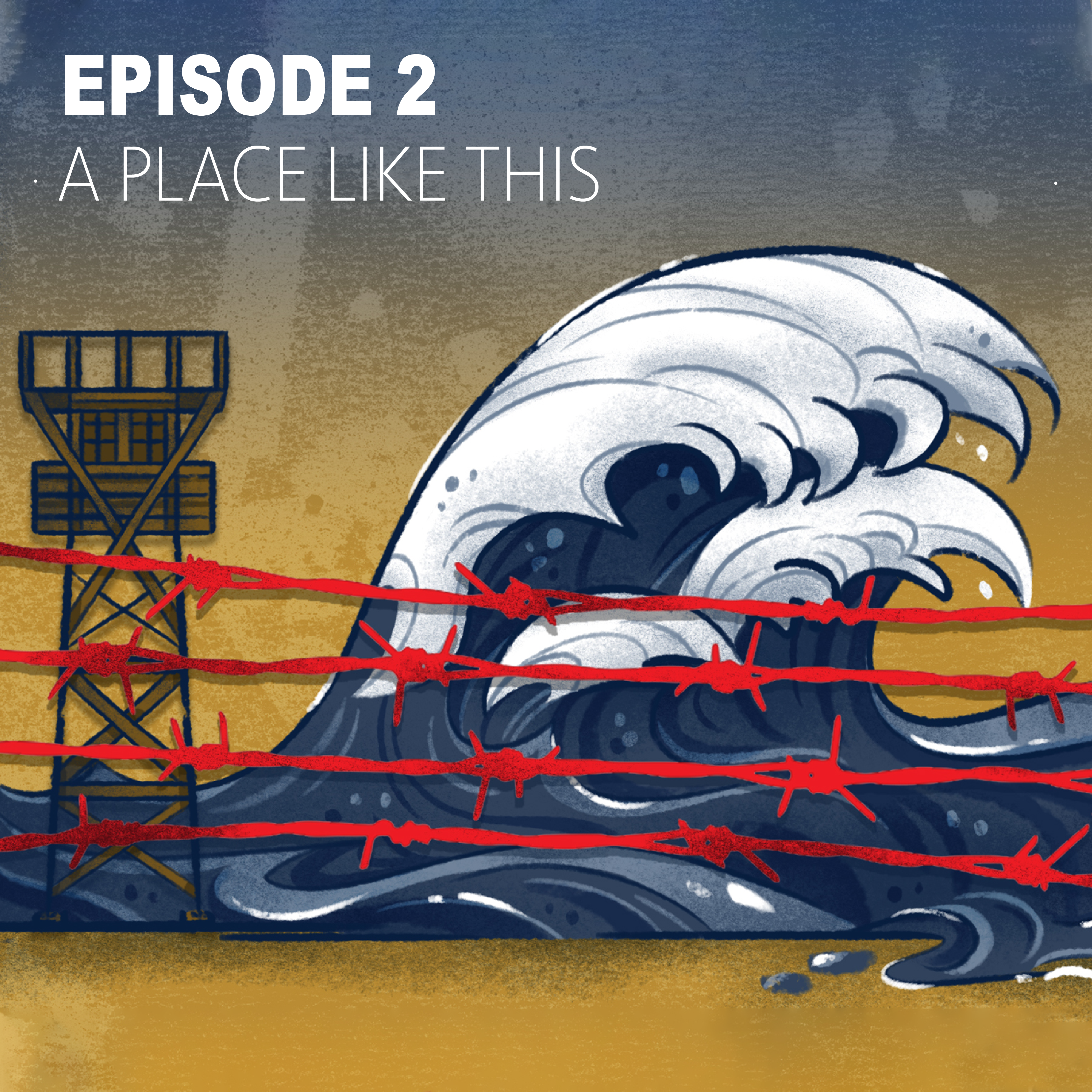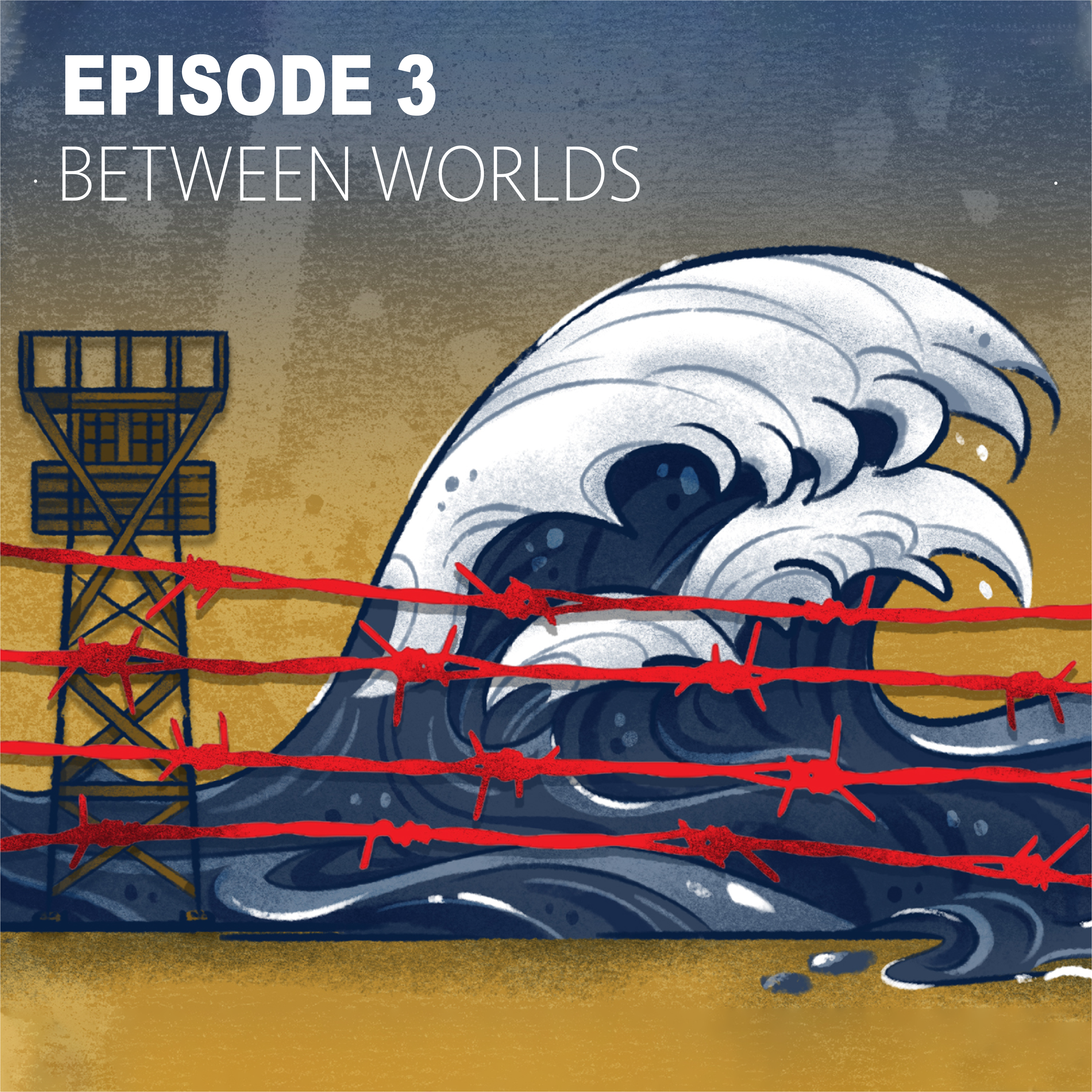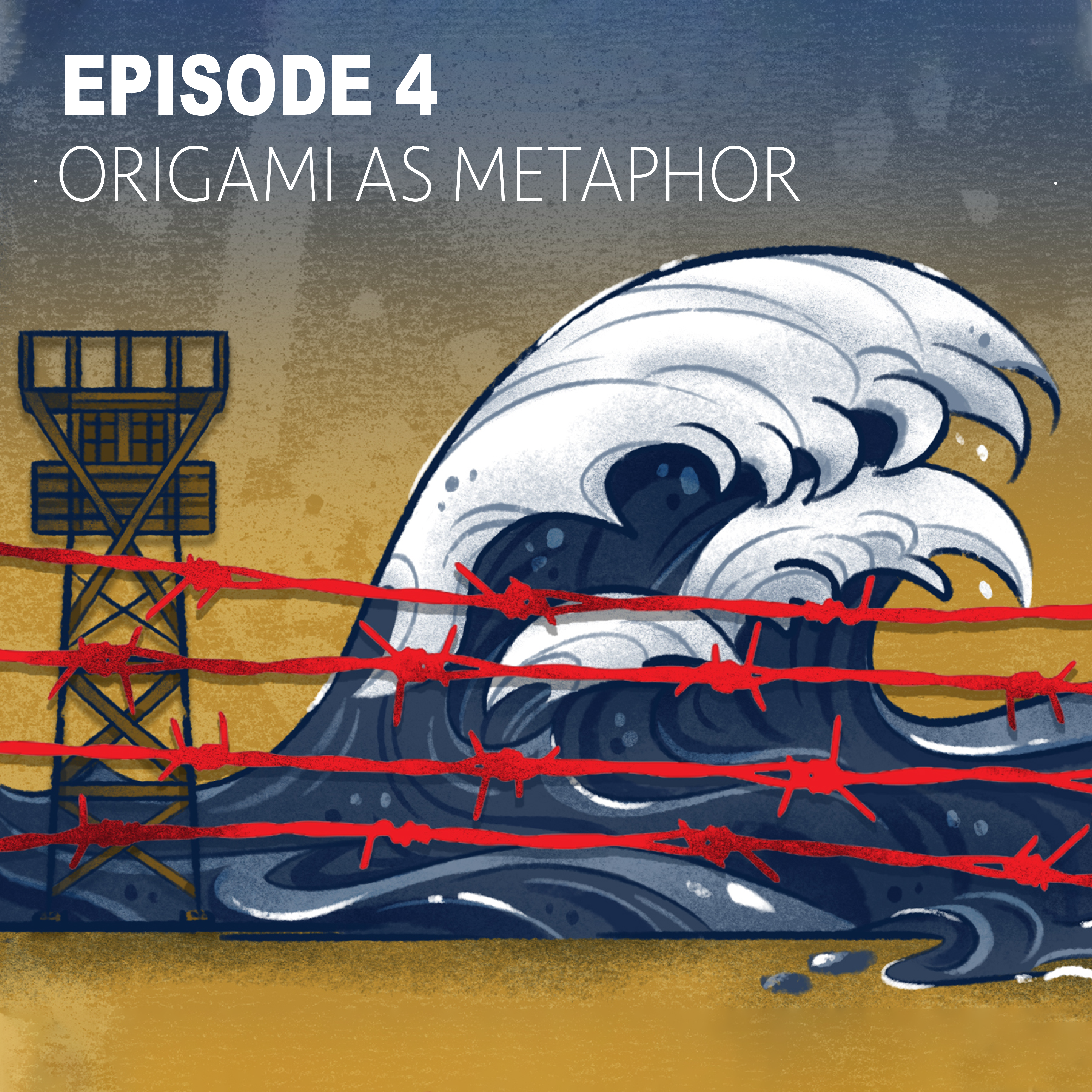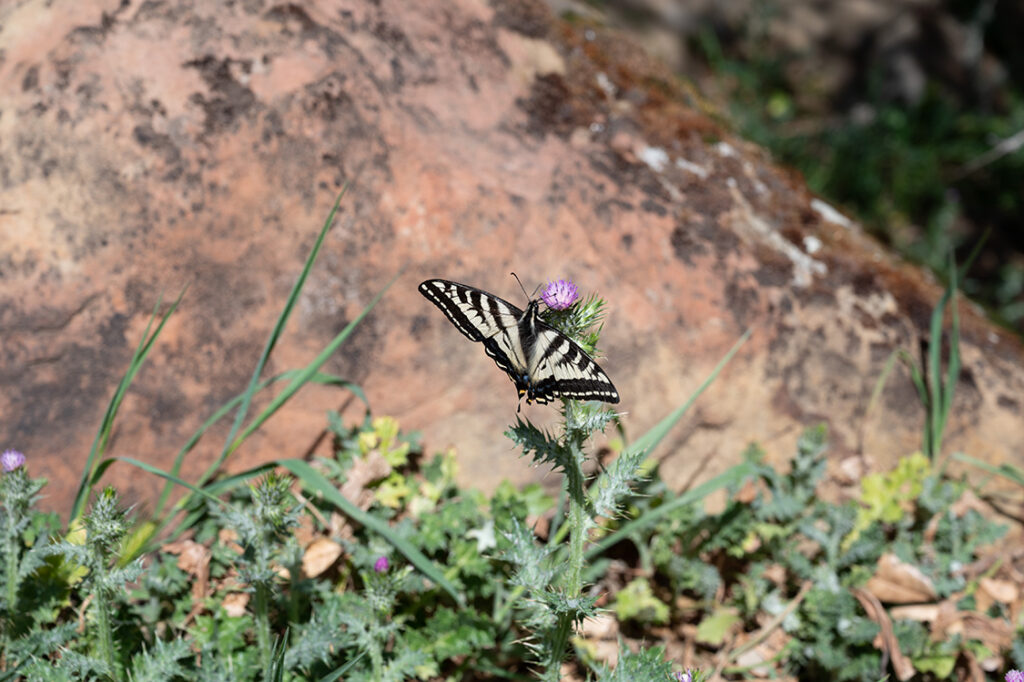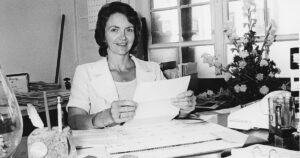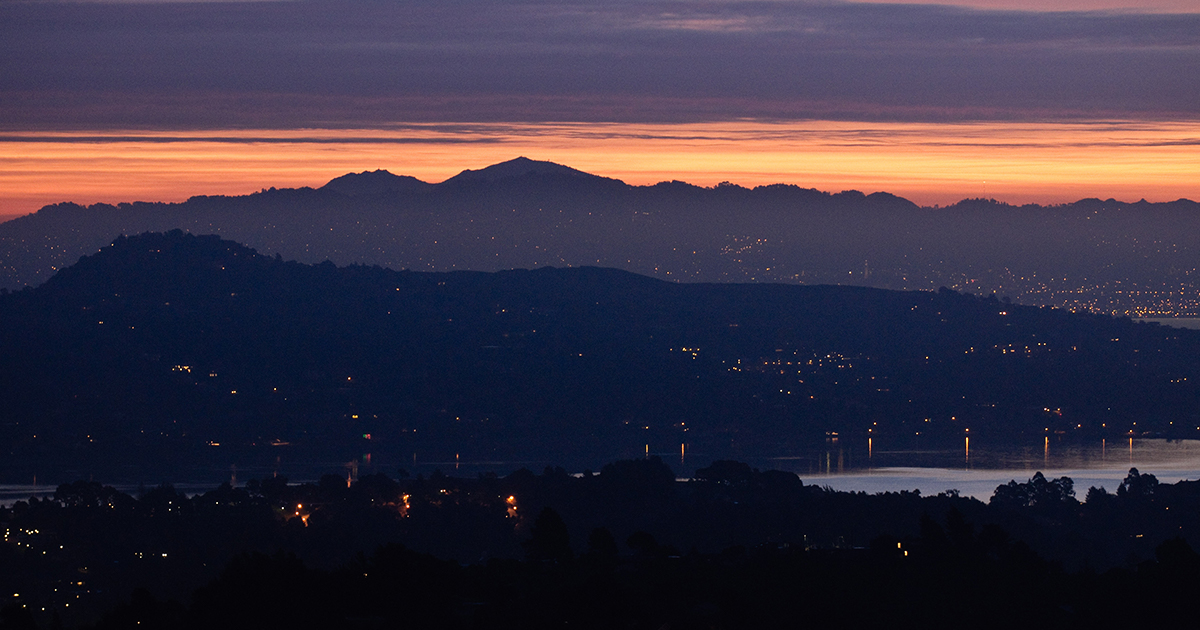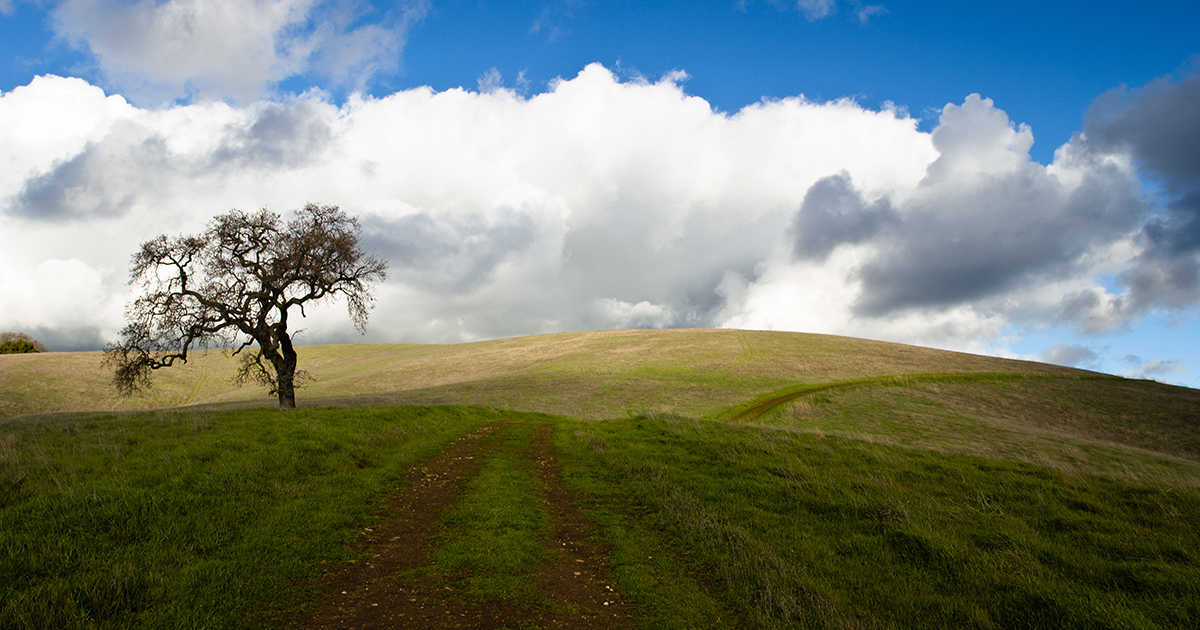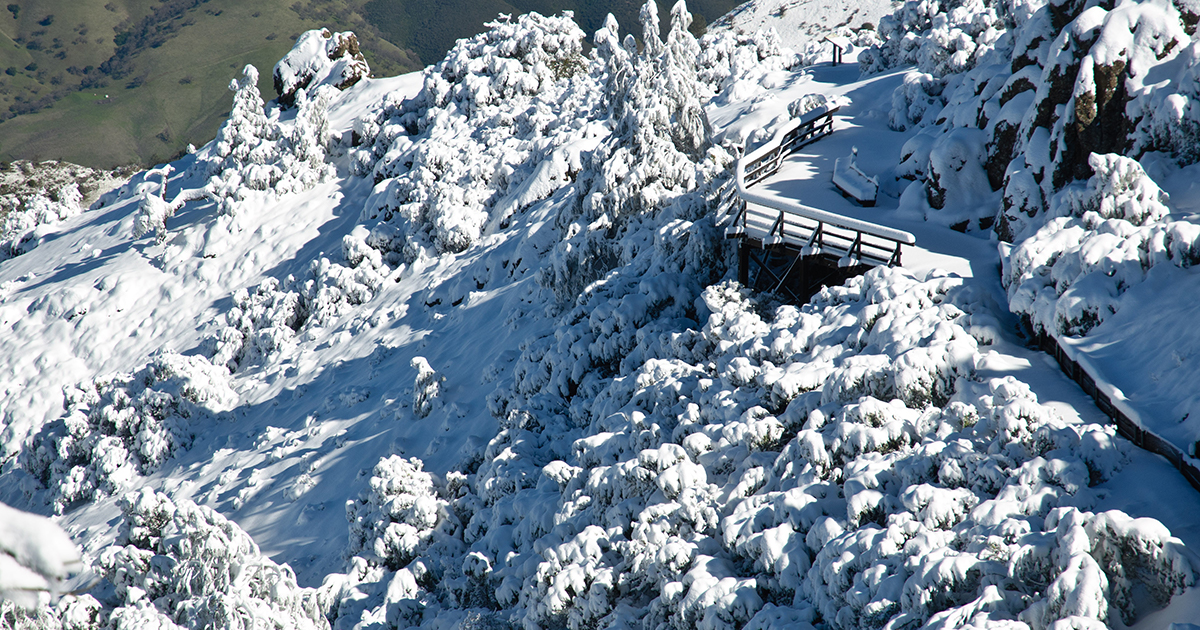Anthology created by the Oral History Center
Research by Sari Morikawa, Serena Ingalls, and Timothy Yue, undergraduate researchers
After the entrance of the United States into World War II, President Franklin D. Roosevelt signed Executive Order 9066 on February 19, 1942, which mandated the forced removal of Japanese Americans from their homes on the West Coast into incarceration camps inland for the duration of the war. This forced removal uprooted families, disrupted businesses, and dispersed communities — impacting generations of Japanese Americans. The Oral History Center, or the OHC, and other archival collections in The Bancroft Library, feature several projects on this chapter of American history, comprising hundreds of interviews, photographs, artifacts, graphic illustrations, and podcasts for use by scholars and the public.
Find these interviews and all our oral histories from the search feature on our home page. You can search by name, keyword, and several other criteria. Find all the oral history projects mentioned here, along with more in-depth descriptions, on our projects page.
There are six parts to this collection guide to Oral History Center and other Bancroft Library resources:
- Projects about Japanese American incarceration
- Related projects
- Individual interviews
- How to search our collection
- Selected articles that highlight and synthesize this work
- Acknowledgements
Part 1: Projects about Japanese American Incarceration
Japanese American Intergenerational Narratives
The Japanese American Intergenerational Narratives Oral History Project is the OHC’s newest project on this subject, consisting of interviews with child survivors and descendants of those who were incarcerated. The project documents the ways in which intergenerational trauma and healing occurred after the United States government’s incarceration of Japanese Americans during World War II. Conducted by Roger Eardley-Pryor, Shanna Farrell, and Amanda Tewes, these interviews examine and compare how private memory, creative expression, place, and public interpretation intersect at sites of incarceration. Initial interviews focus on the Manzanar and Topaz prison camps, and pose a comparison through the lens of place, popular culture, and collective memory. Exploring narratives of healing as a through line, these interviews investigate the impact of different types of healing, how this informs collective memory, and how these narratives change across generations. The first set of interviews, comprised of 100 hours of oral history interviews with 23 narrators, continues to grow with interviews featuring child survivors and descendants of the Heart Mountain and Tule Lake prison camps.
“‘Dad, were you put in the camps?’ They didn’t talk about it. It was something you didn’t bring up…. He was honest but then he said, ‘But that happened in the past. You don’t need to dwell.’”
—Peggy Takahashi, on intergenerational silence related to her family’s incarceration
The project includes interpretive materials as well. Season eight of The Berkeley Remix, the OHC’s podcast based on oral history, explores themes from the project’s initial oral histories. “‘From Generation to Generation’: The Legacy of Japanese American Incarceration,” is a four-episode season featuring stories of activism, contested memory, identity and belonging, as well as artistic expression and memorialization of incarceration. In addition, ten graphic narrative illustrations created by artist Emily Ehlen vividly express the experiences of Japanese American incarceration during World War II and its effects on future generations. The interpretive materials, along with the oral histories, are available for use in classrooms.
Japanese American Confinement Sites
Interviews in the Japanese American Confinement Sites Oral History Project document the experiences of Japanese Americans who were incarcerated during World War II, including UC Berkeley students who attended college before or after the war. Themes running through these interviews include the experiences of forced relocation and incarceration; loss of property and livelihoods; identity; education; challenges faced after the end of the war; and emotional responses to their experiences. Many of the narrators went into fields such as public service, the military, advocacy, art, and education; some of them participated actively in the redress movement.
“Never again should there be such an event as a mass removal of an entire group of people without due process of law. … I try to pass that message on to as many people as I can.”
—Sam Mihara explains why he decided to become a speaker and share his stories
The voices of these narrators are brought to life in the slideshow: “The Uprooted: The Incarceration of Japanese Americans.” This slideshow was made to accompany the 2021–2022 exhibition in The Bancroft Library Gallery, “Uprooted: The Incarceration of Japanese Americans.” All photographs were drawn from the War Relocation Authority Photographs of Japanese American Evacuation and Resettlement, 1942–1945, The Bancroft Library, University of California, Berkeley, BANC PIC 1967.014–PIC. The oral histories are from the Japanese American Confinement Sites Oral History Project.
Japanese-American Relocation Reviewed
Japanese-American Relocation Reviewed is a multi-interview volume of oral histories from the Earl Warren in California project, dedicated to a discussion of Japanese American incarceration. In “Volume I: Decision and Exodus,” staff of the Justice Department, legal advisors to the US Army, and US and California State attorneys discuss the role of the US Department of Justice and the Western Defense Command in defining and administering policy towards enemy nationals, California Attorney General Earl Warren’s role in the forced removal of Japanese Americans to incarceration camps, the civil defense program, martial law, and the development of a constitutional argument for forced removal.
“We kept saying that we won’t do it and haven’t got the authority to do it. And there are enough precedents, you know with Lincoln suspending the writ of habeas corpus, that if the military wanted to do it, they could do it. But we frankly never thought they would. We thought they were too damn busy getting the troops to go fight a war some place else. That was our mistake.”
—James Rowe, assistant to United States Attorney General Francis Biddle
In “Volume II: The Internment,” members of the War Relocation Authority discuss the authority, selection, and administration of incarceration camp sites; resettlement out of the incarceration camps; origin and activities of the Pacific Coast Committee on American Principles and Fair Play. It also includes an appended interview with a wartime YWCA national board member on Idaho’s Minidoka camp in 1943; an address given by Robert B. Cozzens in 1945, “The Future of America’s Japanese;” and reproductions of Hisako Hibi’s paintings of Tanforan and Topaz.
The Office of Redress Administration Oral History Project
In 1988, President Ronald Reagan signed the Civil Liberties Act, a historic piece of legislation that sought, for the first time, to provide a measure of justice to Japanese Americans forty-six years after their incarceration during World War II. Over its decade-long operation (1988–1998), the Office of Redress Administration reached over 82,000 people with a redress payment and official apology letter from the President of the United States. Redress: An Oral History Project, by Emi Kuboyama, project creator and interviewer, with Todd Holmes, Oral History Center historian and interviewer, documents the complex history of Japanese American redress. The film, Redress, provides the first in-depth look at the historic program as told by both those who administered and participated in it. Additional educational materials supplement the film by providing historical overviews of the Japanese American experience and redress program, as well as a list of resources for further study and discussion. The project received the generous support of the Henri and Tomoye Takahashi Foundation and the National Park Service, US Department of Interior.
The Japanese American Evacuation and Resettlement Records and Japanese American Relocation Digital Archive
The Bancroft Library’s documentation of the Japanese American experience during World War II includes thousands of primary source materials drawn from an extensive collection of manuscripts, photographs, as well as audio and video. The Japanese American Evacuation and Resettlement Records, accessible through the Online Archive of California, consists of surplus copies of U.S. War Relocation Authority agency documents, including publications, staff papers, reports, correspondences, press releases, newspaper clippings, scrapbooks and a few photographs. Included is the Japanese American Evacuation and Resettlement Study, University of California, Berkeley, 1942-1946, containing diaries, letters and staff correspondence, reports and studies. These records include 250.5 linear feet (335 boxes, 84 cartons, 41 oversize volumes (folios), 7 oversize folders, 2 oversize boxes; 380 microfilm reels; 5,660 digital objects) (BANC MSS 67/14 c). The related Finding Aid to the Japanese American Evacuation and Resettlement Records 1930-1974 provides additional detail about the collection, including acquisition information, historic notes, scope, and contents.
In addition, Calisphere hosts the Japanese American Relocation Digital Archive (JARDA), which contains thousands of primary sources documenting Japanese American incarceration, including: personal diaries, letters, photographs, and drawings; US War Relocation Authority materials, including newsletters, final reports, photographs, and other documents relating to the day-to-day administration; and personal histories documenting the lives of the people who were incarcerated in the camps, as well as of the administrators who created and worked there. Curated by the University of California, JARDA makes accessible materials from libraries, museums, archives, and oral history programs across California.
Part 2: Related Projects
Rosie the Riveter World War II American Home Front Oral History Project
The Rosie the Riveter World War II American Home Front Oral History Project comprises more than 200 interviews with women and men about the home front experience in the Bay Area. Many of the interviews in these projects include either brief references to or longer discussions about the World War II-era incarceration of Japanese Americans, and cover a broad range of experiences from a multiplicity of perspectives. Some interviews feature individuals who were incarcerated, while other interviews feature Japanese Americans in Hawaii and elsewhere who were not, but who recalled being affected by fear and prejudice. Other interviews include people who were friends, classmates, neighbors, and coworkers, who recalled the forced removal, and the emotions they experienced. Some of these acquaintances were troubled or appalled, whereas others were relieved and thought it justified. Some took care of farms and property until their neighbors returned; others benefited financially. Some go into great detail about race relations in farming and other communities throughout California.
“We used to say, now, why did they make all the Japanese pilots look so ugly?”
—Gladys Okada, in reference to World War II American war films
Volumes about Earl Warren
Two projects, Earl Warren in California and Law Clerks of Earl Warren, center around Earl Warren, who was California’s attorney general (1939–43) and governor (1943–53), before becoming chief justice of the Supreme Court (1953–69), and include an interview with Warren himself. The California project focuses on the years 1925–53, and documents the executive branch, the legislature, criminal justice, and political campaigns; Warren’s life; and changes in California during this period. The California project includes numerous multi-interview volumes that address different issues, including two volumes on labor, exploring Warren from the perspective of union members and labor leaders. The Law Clerks project comprises interviews of more than 40 of Warren’s law clerks; these narrators discuss watershed cases, the evolution of constitutional law, and other issues related to the court. Among other subjects, issues that arose in the interviews in these projects included the ways in which the narrators responded to the executive order; economic, military, and other motivations for the order; the process of identifying individuals and where they lived; reparations; economic consequences; and reflections on Warren’s actions and opinions. Earl Warren himself, in his interview, Conversations with Earl Warren on California Government, briefly addresses the incarceration and aftermath, including enforcement and other issues related to the Alien Land law, preparation of maps documenting where Japanese nationals and Japanese Americans lived, rationale for incarceration, reparations, and return from the camps.
“‘We urge you to appoint immediately a trustee to hold in trust all the properties of the Japanese in this state… lest they be taken over by the wolves.’ They didn’t do anything. All the wolves came in and took over their property.”
—Richard Perrin Graves, executive of the League of California Cities and member of the Ninth Regional Civil Defense Board, on his telegram to the US attorney general
Related Papers
The Bancroft Library and greater UC Berkeley Library have extensive collections that address Japanese American incarceration during World War II and related matters. Here are a few. The complete files of the Fair Play Committee (Pacific Coast Committee on American Principles and Fair Play) are held in the library and include a comprehensive file of newspaper clippings from West Coast publications. The papers of Senator Hiram W. Johnson have information on land laws and Asian immigration. Senator James D. Phelan‘s records document anti-Japanese sentiment in the 1920s. The papers of Robert W. Kenny, who succeeded Earl Warren as attorney general in 1943, have information on law enforcement questions in the aftermath of forced relocation.
Part 3: Individual interviews
“We can’t deny that the black people who lived in the Western Addition moved into places that were vacated because [of] the Japanese Americans who were put into internment camps. Our relationship with Japanese Americans is somehow affected by that history.”
—Carl Anthony, architect and environmental justice activist
Dozens of individual interviews scattered throughout the Oral History Center archive, with people from different backgrounds and walks of life, also detail many facets of this chapter in history. Although they were interviewed about other matters, the narrators in their oral histories in some way addressed Japanese American incarceration — sometimes only in passing, at other times more in depth. Some of the more well-known narrators include the following. Photographers Ansel Adams and Dorothea Lange discuss the artistic process, the ownership of their photographs, and the conditions in the camps. Willie Brown, speaker of the California Assembly and mayor of San Francisco, and Carl Anthony, architect and environmental justice activist, address race relations and how some black communities may have benefited from the forced relocation of Japanese Americans. Thomas Chinn, a historian and publisher of the Chinese Digest, discusses the evolution of race relations between Chinese and Japanese Americans in the United States, and noted that after Pearl Harbor, some people in Chinese communities wanted to distinguish themselves in order to avoid the same fate. Japanese American artist Ruth Asawa details her father being taken away by the FBI, her family’s subsequent incarceration, and the role incarceration played in her development as an artist.
“All this equipment my father had gathered — the books, everything that had to do with Japan — they just made a big bonfire and burned all of that. Everybody had panicked at that time. My sister cried and she said, ‘Oh, please don’t, don’t burn the books.’”
— Ruth Asawa, artist, on the fear her family experienced after her father was taken away
The best way to find individual OHC interviews that address any subject is to search by keyword from the search feature on our home page. Use as many keywords as you can think of (one at a time) that might relate to the topic. When you get to the results page, you will see a list of oral histories. Click on any one to get to detailed metadata about that oral history, plus access to the PDF of the oral history itself. As a first step, the abstract provides an overview of the major themes in the oral history. For a more comprehensive look, you can open the oral history directly from this page within digital collections; then use the search feature from within the oral history to find keywords. The oral history will also have a table of contents, and some also have an interview history and other front matter that will provide more information.
Part 4: How to search our collection:
Browse and access all of the oral history projects mentioned in this collection guide from the Oral History Center’s projects page. The projects page will provide a description of the project, and a list of all the oral histories on that project in the UC Library’s digital collections. To search the OHC’s archive by name, keyword, and other criteria, go to the OHC search feature on our home page. The OHC’s guides to various subjects in our collection can be accessed from the collections guide page. If you’re interested in making a documentary, podcast, or in undertaking other creative endeavors, you can access the audio/video and any related photos or ephemera through The Bancroft Library. You will need to open an account to order and access materials in the Reading Room. And here is more information about Rights and Permissions.
Explore collections related to Japanese American incarceration during World War II at all UC campuses by going to the UC Library Search. To explore all holdings from The Bancroft Library, go to the Advanced Search option from the Library Search page, and check “UC Berkeley Special Collections and Archives,” then search by keyword and other criteria.
Part 5: Selected articles that highlight and synthesize this work
The Oral History Center Presents the Japanese American Intergenerational Narratives Project, by Shanna Farrell
The Oral History Center Presents The Berkeley Remix Season 8: “‘From Generation to Generation’: The Legacy of Japanese American Incarceration” by Amanda Tewes
Graphic Narrative Art by Emily Ehlen from OHC’s Japanese American Intergenerational Narratives Oral History Project, by Roger Eardley-Pryor
Q&A with Artist Emily Ehlen on Illustrating the OHC’s Japanese American Intergenerational Narratives Oral History Project, by Roger Eardley-Pryor
New podcast series explores the legacy of Japanese American incarceration: Read a Q&A with the Oral History Center’s Shanna Farrell about the Project, by UC Berkeley News reporter Anne Brice
‘I knew I had to draw it’: Illustrator brings to life testimonies of Japanese Americans incarcerated during WWII and their descendants in new Oral History Center project, by Dan Vaccaro, writer for UC Library Communications
Interconnections, by Roger Eardley-Pryor
Out of the Archives: Patrick Hayashi: From Mail Carrier to Associate President to Artist, by UC Berkeley undergraduate research apprentice Zachary Matsumoto
OHC URAP Student Zachary Matsumoto Reflects on Work with Japanese American Intergenerational Narratives Project, by UC Berkeley undergraduate research apprentice Zachary Matsumoto
‘Never again’: Library exhibit tells story of WWII Japanese American incarceration, sounds alarm on importance of remembering by Dan Vaccaro, writer for UC Library Communications
Oral history project highlights the little-known Japanese American redress program, by UC Berkeley News reporter Anne Brice
Redress: A film about the Office of Redress Administration by Edna Horiuchi in Discover Nikkei
Janet Daijogo: Japanese Incarceration and Finding Her Place through Aikido and Teaching, by UC Berkeley undergraduate and Oral History Center research assistant Deborah Qu
Bury the Phonograph: Oral Histories Preserve Records of Life in Hawaii During World War II, by UC Berkeley undergraduate and Oral History Center editorial assistant Shannon White
Part 6: Acknowledgements
National Park Service, Department of Interior
The following projects were funded, in part, by a grant from the US Department of the Interior, National Park Service, Japanese American Confinement Sites Grant Program. The views and conclusions contained in this document are those of the authors and should not be interpreted as representing the opinions or policies of the US Government. Mention of trade names or commercial products does not constitute their endorsement by the US Government.
Japanese American Confinement Sites Oral History Project
Japanese American Intergenerational Narratives Oral History Project
Japanese American Evacuation and Resettlement Records
Office of Redress Administration Oral History Project
Henri and Tomoye Takahashi Foundation
The Office of Redress Administration Oral History Project received generous support from the Henri and Tomoye Takahashi Foundation. The foundation also provided generous support for a second phase of interviews for the Japanese American Intergenerational Narratives Oral History Project.
About the Oral History Center
UC Berkeley’s Oral History Center, or the OHC, is one of the oldest oral history programs in the world. We produce carefully researched, recorded, and transcribed oral histories and interpretive materials for the widest possible use. Since 1953 we have been preserving voices of people from all walks of life, with varying perspectives, experiences, pursuits, and backgrounds. We are committed to open access and our oral histories and interpretive materials are available online at no cost to scholars and the public. You can find our oral histories from the search feature on our home page. Search by name, keyword, and several other criteria. Sign up for our monthly newsletter featuring think pieces, new releases, podcasts, Q&As, and everything oral history. Access the most recent articles from our home page or go straight to our blog home.
Please consider making a tax-deductible donation to the Oral History Center if you would like to see more work like this conducted and made freely available online. The Oral History Center is a predominantly self-funded research unit of The Bancroft Library. As such, we must raise the funds to cover the cost of all the work we do, including each oral history. You can give online, or contact us at ohc@berkeley.edu for more information about our funding needs for present and future projects.
